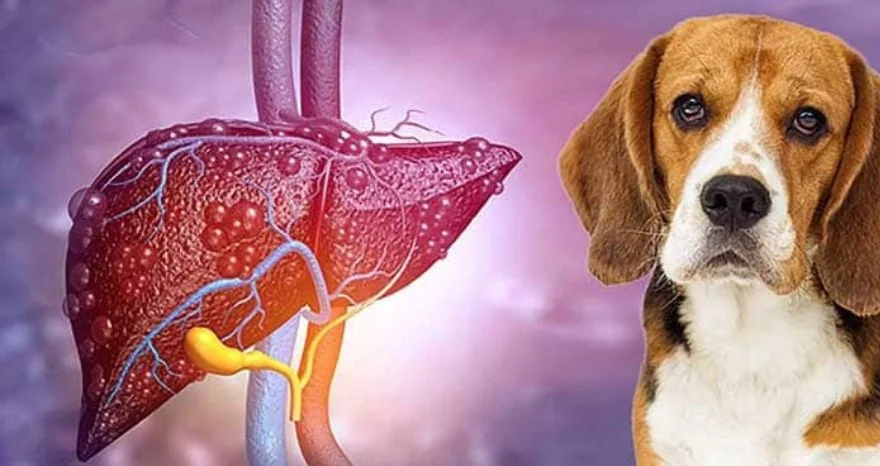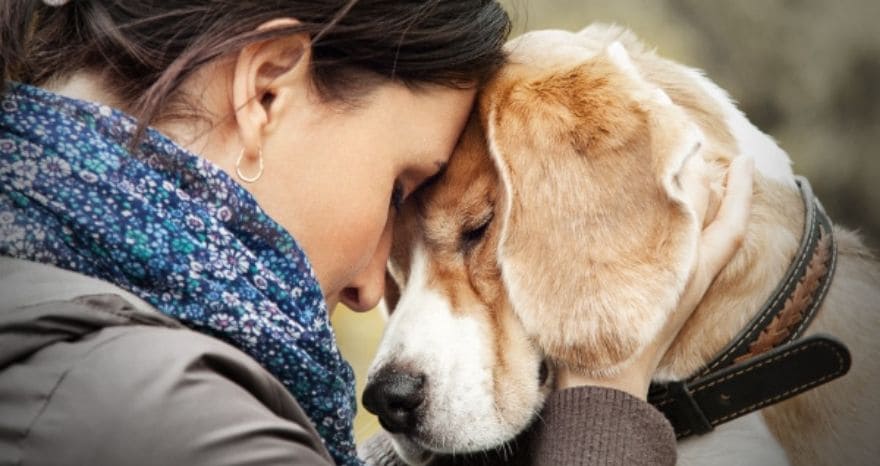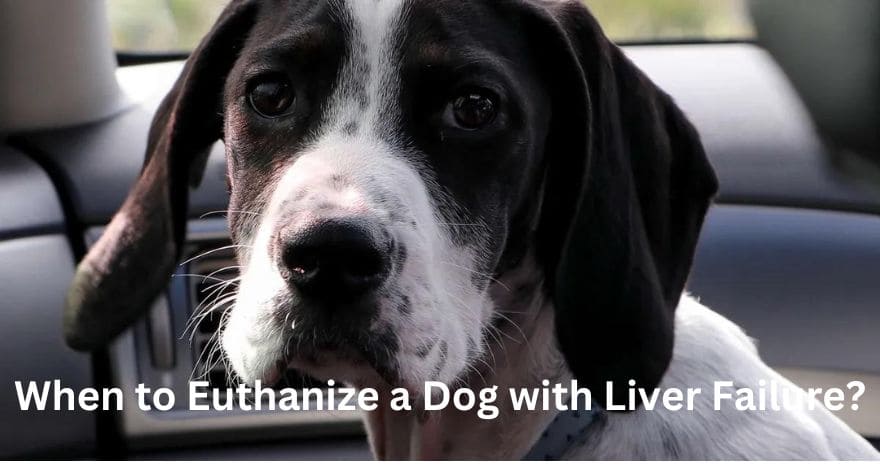Are you in concern, when to euthanize a dog with liver failure? It can be one of your most difficult decisions. Many dog diseases will eventually develop where we need to make a decision, and liver failure is one of them.
Nursing a dog with liver failure is like a boring long train journey for numerous pet owners. If your dog has a better day, you turn on distress the moods you had earlier in the day, it’s time to let it go. However, it can be a tough and emotional time for you, your puppy, and your family.
What is Liver Failure?
Liver failure or Hepatic failure, also commonly recognized as liver disease, which can affect your most faithful partners. Even though this ailment is painful to evade altogether, it is crucial for you to appreciate its shortcomings. It will help you to relate your puppy at the very beginning of the disease.
Moreover, the liver is the most extensive organ in both humans and dogs. As a result, the body entirely depends on the liver to work usually and help other organs in their regular processing.
Unluckily, as soon as a liver is infected, many side effects and other more severe problems in the body can occur. The faster you can identify the characters, the quicker you can get them on the recovery path.
Reason behind the Liver Disease in Pups
Diagnosing the problem of liver diseases in the early stages can be difficult. As with each and every health problems, genetics and age can be significant causes. But, there are many other reasons. That may include:
- Diabetes.
- Uptake of individual plants, or toxic substances.
- Raw heart failure.
- Viral and bacterial infections.
- Fatty diets.
- Long-term usage of painkillers.
- Pancreas problems.
Symptoms of Liver Failure in Dogs
A puppy with liver ailment will not exhibit any indications until the dilemma worsens without a chance of recovery. If the dog shows any of these symptoms below, it may be due to complications of the liver.
- Increased aggression
- Loss of appetite
- Diarrhea
- Cramps
- Weight loss
- Confusion
- Inability to walk
- Jaundice
- Vomiting
- Weakness
Be aware of the symptoms to take up a quick step if your puppy faces any liver difficulties!
Stage of Liver Disease in Dogs

1st Stage
Abnormal inflammation is the sign of the first stage of liver disease. When there is a pain in the body, this indicates that the affected organ is frustrating to get well from an infection or injury. Veterinarians can generally detect liver diseases with a thorough examination.
With early observation, the veterinarian can usually find and process the source before it develops. Most veterinarians prescribe medications or change diets to treat first stage liver diseases.
2nd Stage
Fibrosis is the sign of the second stage of liver disease. When an inflamed and irritated liver begins to become firm and heal, Fibrosis transpires. A healthy liver become normal tissue into scar tissue in the second stage of the liver disease.
Once fibrosis starts to affect the body, it reduces blood flow and increases liver damage. At this point, blood abnormalities can be determined using a blood test. In fact, it is the last step in which handling can have a significant effect on your dog’s prognosis.
3rd Stage
In this phase, the scar tissue put an incurable spot on your dog’s liver that you could not treat. This phase is called cirrhosis.
As soon as cirrhosis starts to affect the body, the puppy develops more harsh indication. Most of the time, veterinarians work with liver diseases in the third stage will fight to defend the remaining healthy cells.
Last Stage
This is the last stage of liver failure. Your pup’s liver cannot operate properly at this stage of the disease. Also, your puppy falls in a severe condition.
When your puppy has entered this phase, the main task is to make it as relaxed as possible. If you feel your puppy has liver disease, it is ideal to take it directly with the veterinarian as the owner. Once they can diagnose the problem and begin a treatment program, they can quickly solve the underlying issues.
In more severe cases of liver disease, try to make your dog as comfortable as possible. Although it can be challenging to manage your forecasts, you should do everything possible to provide them with a calm and relaxed environment in the last days or months.
What can I feed to My Puppy with Kidney Failure in Its Last Stages?
First of all, I’m sorry if your dogs are going through. Kidney disease is difficult to diagnose because it slowly pushes us away from our partners. I saw this more often than I can count on the vet’s office, and I also lost some of my pets.
They accuse me of this, and that’s normal. I speak from professional and personal experience.
Considering That Your Dog Has an Acceptable Quality of Life, It Is Painless and Can Function Normally
Feed it with what it eats. From now on, remove the restrictions on a low protein / limited diet and just feed any liquid / dry dog food that suits your puppy.
“Kidney food” is designed to slow the progression of the disease by reducing weight on the kidneys. At the advanced stages, there is no turning back. However, less time needs to extend, and it takes more time to maintain the quality of the remaining time.
I saw many pets who denied a kidney diet, and when their owners are afraid to feed anything else because the veterinarian said “ONLY FOOD!” In fact, the dog is almost starving.
Yes, the vet wants to give you the recommended ideal diet. But no veterinarian wants your pet to be hungry. If you have problems, call and discuss an alternative diet plan.
If your dog’s quality of life suffers
Think about human euthanasia. Part of the kidney disease process is an increase in the level of toxins that accumulate in the blood. That’s because the kidneys are no longer able to filter them correctly.
In fact, it causes severe nausea – think about how you feel after you have drunk too much, but it does not go away after sleep. If your dog does not want to eat anything, maybe it indicates nausea is very difficult to control.
There are cures for nausea, but they are not an ideal solution. It’s like putting a bandage on a broken arm. They are more designed for things like dizziness, anesthesia associated with nausea and the passage of G.I. annoyed.
How long can a dog live with high liver enzymes?
According to Emergency Vet USA, liver failure can sometimes develop slowly and sometimes progress faster. Therefore, it is essential not to ignore any signs of liver failure in your dog, as this may affect the need for dog euthanize.

In the early stages of liver failure, we see abnormal inflammation. The leading cause is this persistent inflammation in the liver.
At these stages, your dog’s liver may function, albeit with disabilities. If your veterinarian diagnoses liver failure at an early stage, they try to reduce the disease with the help of special supplements and products.
In the intermediate steps, you may see more apparent problems with your puppy. One thing probably you may notice is jaundice. These are yellowing of the skin and gums and yellowing of white eyes.
When your dog’s liver quits working, it stops producing albumin, a protein that helps retain fluid in your dog’s organs and blood vessels. Since there is no albumin, this fluid seeps in the area around your organs and abdomen. This accumulation of fluid in the abdominal cavity is a clear sign of potential liver failure.
In the terminal stage of liver failure, your dog may experience significant neurological problems. That includes depression and a change in consciousness. That’s because the liver can no longer remove toxins from the body and metabolize proteins.
However, it leads to the accumulation of toxins in your dog’s body and is called liver encephalopathy. If you don’t take proper steps, it may cause the death of your dog. So be watchful on every stage of your dog to keep them always a happy mate.
When to Euthanize a Dog with Liver Failure
We come back to the question of when you need to underestimate your faithful friend. It may depend on several things:
When a dog is hurt
Firstly, we have already concluded that it will be difficult for the dog to recover. Consequently, the dog will eventually die. However, the prognosis is much better if you remove the liver tumor.
In this case, however, we discuss euthanasia, believing that everything has already proven. Hepatic failure is usually not associated with severe pain, but also varies from dog to dog.
In some cases, some puppies develop abdominal distress. If your dog is in pain, it is best to give her a break from the pain.
The situations that lead to the option of euthanasia is that the dog suffers, and there is no way to alleviate the suffering. Sometimes it is difficult to know when a dog is suffering because the old deer is full of spirit.
Therefore, they always smile and wag their tail, even when it hurts. It is essential to look beyond this friendship and joy.
When your vet advises you
For euthanizing a dog with liver failure, you can always ask your veterinarian when this is the right time. In the end, the final decision will be made by you, but the veterinarian will advise you when the puppy will not improve.
If he advises you hence, go ahead and let the pup be painless. A veterinarian will usually help you explore dog treatment options. In fact, they may not advise you to accept the death of your trusted dog, but they will certainly show you the reason for leaving it.
If the dog does not want to eat or drink for liver disease
When the liver is out of order, one of the signs is a total loss of appetite. Even if you give your dog’s favorite food, they will not eat. When a few days have passed since the last time you ate or drank, it was time to euthanize the canine with liver failure.
FAQs
How long does a dog have to live with liver failure?
If left untreated, it can cause the loss of function, since the scar tissue replaces the healthy liver cells. Also, the diseases in other body parts can influence the function of the liver. Luckily, you can efficiently fight liver diseases and make progress. Many dogs live happily ever after being diagnosed.
Are dogs in pain when they have liver failure?
Liver diseases are mostly depending on the cause. They will cause symptoms ranging from hazy to distinct. However, many puppies undergo a general feeling of discomfort that can develop into vomiting, nausea, anorexia, diarrhea, weight loss, and possibly stomach pain. A liver-based prescription can help maintain a liver daily.
What do dogs do when they are about to die?
Here you will know four critical tips for comforting your dog to make her walk as calm as possible. Many puppies will seek solace right that period and may need more care and attention. Rest with your dog and pet for as long as you can. Whisper with the dog and tell it that everything will be fine.
What does end stage liver disease look like in dogs?
Most of the puppies with end-stage liver disease have symptoms associated with the inability of the liver to perform its functions: diarrhea, vomiting, lethargy, bleeding tendency, weight loss, jaundice (yellowing of the eyes and skin), behavioral changes and convulsions in severe cases.
Can you reverse liver failure in dogs?
However, active, irreversible, or treatable chronic hepatitis is often treated with medication and a limited diet. Treatment for cancer or liver tumors depends on the test results and may include chemotherapy, surgery, and drug treatment.
Final Verdict
Hepatic failure occurs when the liver is so damaged that it stops functioning. Due to the role of the liver in removing toxins, its failure has a chaotic effect on your dog’s health. While some diseases develop rapidly and others slower that ensure a decent quality of life, liver failure is one of the conditions that can occur very quickly.
For this reason, most of the dog owners will often need to decide when to euthanize a dog with liver failure. In fact, you will find no definite answer to this decision, and it will vary for each dog.
Continue to give your dog as far love and attention as possible. Speak with veterinarian concerning your problems and try daily assessing your pet’s happiness and pain level.
However, at the same time, make sure you get the job done. When you and your dog are ready to experience, make the last of the best moments with your trusted dogs.

